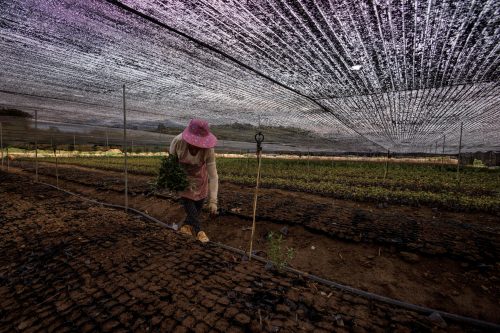[동아시아포럼] 기후 변화가 낳은 중국 곡창지대 위기감
자연재해로 인한 중국 농업 생산량 저하 심각 식량 안보 위협에 수입선 다변화 진행 중 단기적인 식량 생산 전략은 지력 빼앗아 미래 지속 가능한 식량 증산 전략 찾아야
[동아시아포럼]은 EAST ASIA FORUM에서 전하는 동아시아 정책 동향을 담았습니다. EAST ASIA FORUM은 오스트레일리아 국립대학교(Australia National University)의 크로퍼드 공공정책 학교(Crawford School of Public Policy) 산하의 공공정책과 관련된 정치, 경제, 비즈니스, 법률, 안보, 국제관계 및 사회에 대한 분석 및 연구를 위한 플랫폼입니다.
저희 폴리시코리아(The Policy Korea)와 영어 원문 공개 조건으로 콘텐츠 제휴가 진행 중입니다.
지난 5월 폭우로 중국 북부지방의 밀 농장이 침수되면서 중국의 밀 공급량과 식량 안보 사정에 대한 국내외의 관심이 대두되고 있다. 중국 당국 관계자는 밀 생산 시장에 5월 폭우가 지난 10년 이래 ‘가장 심각한 피해를 준 사건’이라고 밝혔다.
지난해 중국 남부 지방은 60년 이래 최고 더위 및 가뭄을 기록한 바 있다. 광역 열풍은 대규모 가뭄을 야기했고, 약 220만 헥타르에 달하는 농지를 파괴한 것으로 알려졌다. 당국은 중국의 벼 곡창지대 중 한 곳인 양자강 분지에 가뭄의 여파가 미치는 것을 우려하는 상황이다.

기후변화에 따른 중국 식량 안보 악화
가뭄, 홍수 같은 자연재앙이 최근 중국 농업 및 식음료 시장에 심각한 타격을 주고 있다. 지난 70년간 중국의 평균 온도는 전 세계 평균치보다 빠르게 상승했고, 이는 홍수, 가뭄, 태풍 등의 자연재해에 직접적으로 노출되는 결과를 낳았다. 특히 여름철 대규모 강우는 지난 20년간 중국의 쌀 생산량을 8%나 감소시켰다.
기후 전문가들에 따르면 향후에도 중국 일대에서 기후 변화에 따른 자연재앙이 발발할 가능성이 높다고 설명한다. 중국 농업도 기후 충격으로 인해 각종 위험을 피할 수 없는 상황에 직면했으며, 작물 재배 조건 및 전략에도 영향을 미침에 따라 장기적으로는 중국의 식량 안보를 위협할 수도 있다는 주장이다.
기후 변화가 확산되면서 가장 크게 대두된 문제는 농업 용수 및 식수 부족이다. 전문가들은 중국 식량 안보에 가장 큰 영향을 미칠 요소로 단기적으로는 제조업 공정에 따른 오염물질, 장기적으로는 식수 부족에 따른 농업 생산 축소를 꼽았다.
핵심 이슈는 식용수 부족
중국은 전 세계 5위권의 수원(水原)을 보유하고 있음에도 불구하고 1인당 식수 공급 가능량은 2018년 세계 평균의 25%에도 못 미치는 상황이다. 더 큰 문제는 식용수의 분배가 한쪽에 치우쳐져 있다는 점이다. 중국 남부 지역은 주기적으로 홍수를 겪는 반면, 북부 지역은 가뭄이 흔하다.
기후 변화에 따른 식량 생산 전략 변경도 식용수 부족 문제를 부채질하고 있다. 식량 자급률을 끌어올리기 위해 중국 정부는 개발 진행이 늦은 내륙 지역으로 식량 생산 중심지를 옮기고 있으나, 내륙 및 북부 지역은 식수가 부족한 지역이다. 지난 1995년 중국 북부 지방은 중국 전체의 46% 곡물을 생산했으나 2021년 들어서는 60% 이상을 생산하는 곳으로 바뀌었다. 그러나 북부 지역 전체의 식용수 비중은 중국 전체의 24%에 불과하다.
지난 1995년부터 2021년 사이 중국 북부 지역의 식량 생산량은 2억 톤가량 증가한 반면, 식용수가 상대적으로 풍부한 남부 지역의 생산량은 크게 바뀌지 않았다. 하남성, 산동성, 하북성 등지는 중국 전체 식용수의 4%를 보유하고 있으나 농업 생산량은 무려 24%에 달한다.
식수 부족 지역에 환경 오염 문제도
북부 지방의 관계 수로 확장 덕분에 북부 지역 곡물 생산이 비약적으로 늘어났으나 지표면 수량이 부족하고 강수량이 적어 장기적인 해결책은 될 수 없는 상황이다.
농업 용수에 대한 지표수 의존이 심해지면서 환경 오염도 발생하게 됐다. 지난 1990년대부터 지표수 과다 추출은 중국 북부 지역의 주요 환경 문제로 대두됐고, 화학 비료 및 살충제 과다 사용까지 겹쳐 토지 지질 악화 및 주변 지역 오염이라는 최악의 결과를 낳은 상태다.
기후 변화로 인해 식용수 부족 문제가 악화되면서 중국의 식량 안보에 대한 우려도 커질 수밖에 없는 상황이 됐다. 엘리뇨 효과는 양자강 분지 지역 기후에 대한 불확실성을 증폭시켰고, 중국 남부 지역 홍수, 북부 지역 가뭄, 북동부 지역의 서늘한 여름 등 이상 기후 현상이 반복적으로 나타나게 했다. 이뿐만 아니라 기후 변화에 따라 물 부족 사태가 확산됐고, 지역간 경제 발전 격차가 더 커지는 문제도 낳았다.
식량 수입 증가에 따른 국제 무역 시장 변동
문제는 중국이 전 세계 최대 식량 생산국인 동시에 최대 수입국이라는 점이다. 중국 내부에서 약간의 식량 정책 변화만 있어도 그 변화는 즉각 전 세계적인 식량 사정 변화로 나타날 수 있다. 실제로 하남성을 비롯한 주요 밀 생산 지역이 홍수로 생산에 어려움을 격차 중국은 올해 들어 벌써 1,200만 톤의 밀을 수입했다.
중국 정부 당국은 식량 생산 증산을 위해 농촌에 대한 정책 지원을 추가하고, 지방 정부들이 농지를 보호하도록 압박하고 있으나 식용수 부족에 발목이 잡힌 상태다. 최근 들어서는 ‘애그테크(AgTech, 농업과 기술을 합한 산업)’ 분야에 대한 투자도 이어져 유전자 조작 곡물, 대체 작물, 농업 자동화, 인공지능 도입 등에도 박차를 가하고 있다.
이어 잔반 남기지 않기 캠페인, 동물 사료에 옥수수 및 콩 쓰기 등을 통해 식량 보존 정책도 진행 중이다. 수입선 다변화 전략도 관측된다. 해외 직접 투자, 국제 농업 협력 같은 대외 채널을 통해서도 식량 부족분을 채워 넣겠다는 방침이다.
전문가들은 기술 개발을 통한 식량 안보 개선 전략의 장점은 인정하면서도 지력을 과도하게 빼앗는 집중 농업 전략이 장기적으로는 중국 식량 안보의 미래를 갉아먹을 수 있다며 경계의 목소리를 내고 있다. 특히 기후 변화에 순응하지 않고 더더욱 북부 내륙 지역에 농업 생산력을 의존할 경우 수십 년 내에 식량 안보가 크게 위협받을 가능성도 제기됐다.
Climate change threatens China’s rice bowl
Downpours in late May 2023 in northern China flooded wheat fields, stirring both domestic and international concern about China’s wheat supply and the potential impacts on food security. Chinese officials described the flooding as ‘the most destructive rain event’ for wheat production in the past decade.
![]()
In 2022, southern China suffered the country’s driest and hottest summer in six decades. The severe heatwave resulted in a massive drought, affecting an estimated 2.2 million hectares of farmland. Chinese officials are now concerned that drought could hit the Yangtze River basin, China’s main rice-growing region.
Extreme weather such as drought and floods have become major threats to China’s agricultural and food supplies. Over the past 70 years, China’s average temperature has risen faster than the global average, making the country extremely vulnerable to floods, droughts and typhoons. Extreme rainfall has reduced China’s rice yields by 8 per cent over the past two decades.
Extreme climate events are expected to occur with increasing frequency in China, jeopardising its food security plan. China’s agricultural sector is facing growing risks as a result of climate shocks and shifting planting conditions brought about by global warming.
Water shortages are the most significant and potentially most impactful component of the wider climate crisis. China will be among the most affected by water shortages. Water shortage and pollution have long been regarded as one of the top threats to the country’s food security.
Despite having the fifth-highest volume of renewable freshwater resources in the world, China’s per capita water resources were less than 25 per cent of the world average in 2018. Worse still, the country’s freshwater resources are unevenly distributed across regions — the south faces periodic floods while the north battles frequent droughts.
The shift in China’s crop structure and spatial changes in grain production has made the water challenge even more daunting. To maintain grain self-sufficiency, China increased grain production by moving production to less-developed areas within the country, mostly to the inland and northern regions. In 1995, China’s northern provinces produced 46 per cent of the country’s grain and by 2021 this share had increased to 60 per cent. Yet the northern provinces have only 24 per cent of China’s freshwater resources.
Between 1995 and 2021, grain output in the northern provinces increased by nearly 200 million tonnes, whereas grain production in the southern provinces only increased marginally. Henan, Shandong and Hebei provinces, with only 4 per cent of the country’s surface water resources, produced 24 per cent of China’s grain.
The expansion of irrigated land, especially in the north, was one of the key contributors to China’s remarkable increase in grain production over the past decades. In China’s northern provinces, where rainfall and surface water resources are low, groundwater irrigation is vital.
Reliance on groundwater has resulted in over-extraction and adverse environmental effects. Since the late 1990s, groundwater overdraft has become one of China’s most serious resource problems. Apart from water-scarcity challenges, the excessive use of chemical fertilisers and pesticides coupled with intensive farming practices have worsened land degradation and pollution.
Climate change threatens to exacerbate the water shortage, undermining China’s food security. The El Nino effect will cause increased climate uncertainty in the Yangtze River basin, causing flooding in the south, drought in the north and a cold summer in the northeast — aggravating water scarcity and regional disparities.
As the world’s largest food producer and importer, minor fluctuations in China’s domestic food production and adjustments in its agricultural trade policy heavily influence global food trade. The loss of wheat in Henan and other grain-producing provinces after the recent rain could mean China’s wheat imports reach 12 million tonnes in 2023.
The Chinese government is aware of the climate threats and water risks around providing enough food for its population and has enacted a wide range of policies in response.
The government has attempted to boost domestic grain production by providing more financial and policy support, pressing local governments to focus more on grain production and introducing stricter rules on farmland protection and usage. It has also invested heavily in agricultural technologies — from genetically modified crops to space seed breeding, alternative proteins and agricultural autonomous systems and artificial intelligence.
The government launched a nationwide campaign to cut food waste and soybean and corn use in animal feed, aiming to reduce demand for food and feed grains. It has also been undertaking various attempts to enhance its external food supply resilience through import diversification, overseas investment and by creating new supply routes and fostering international cooperation.
Facing growing threats from extreme climate events, these measures can be expected to yield mixed results. Some measures have the potential to contribute to domestic and global food supply resilience, albeit not without controversy. These measures include developing drought- and insect-resistant and salt-tolerant crops, investing in artificial or alternative proteins, boosting overseas agricultural investment and technological transfer and creating new food transportation routes.
Other measures, though, including forcefully boosting domestic grain production through intensive farming and reliance on coal-based fertiliser, will not only threaten the long-term sustainability of China’s food production but also undermine its plans to fight climate change.
Facing increasing threats from climate change, China needs to strike the right balance between boosting domestic grain production and water security. The current policy of pressuring dry northern provinces to produce more grain might make China’s food system even more vulnerable to climate shocks. Rather, China needs to tap the potential of southern rain-fed provinces to grow more grains. It is also in China’s interest to step up global agricultural investment and agricultural technology transfers.
Only through a balanced strategy that integrates regional strengths within China and leverages global agricultural cooperation can China build resilience against climate change, secure a stable food supply and maintain its key role in global food trade.
원문의 저자는 짱 홍쪼우(Hongzhou Zhang) 난양공과대학 산하 라자라트남 국제 프로그램의 중국 담당 연구원입니다.




![[동아시아포럼] 인도의 쌀 수출금지 조치가 세계 식량안보에 미치는 영향](https://policyecon.com/wp-content/uploads/sites/7/2023/08/기사-11.jpg)

![[동아시아포럼] 아시아의 인구 감소 해결책, 늦진 않았지만 낭비할 시간도 없다](https://policyecon.com/wp-content/uploads/sites/7/2023/07/2023-01-17T020145Z_359671998_RC2VQY9SF17A_RTRMADP_3_CHINA-ECONOMY-DEMOGRAPHICS-400x267-1.jpg)
![[동아시아포럼] 일본, 태평양 지역에서 영향력 넓혀가는 중국에 어떻게 대응할까](https://policyecon.com/wp-content/uploads/sites/7/2023/05/2022-07-22T000000Z_992605190_MT1KYODO000E72FOK_RTRMADP_3_CHINA-S-INVESTMENT-IN-SOLOMON-ISLANDS-768x512-1.jpg)
![[동아시아포럼] 인도·캐나다 간 외교 갈등과 서구의 대응 전략](https://policyecon.com/wp-content/uploads/sites/7/2023/10/기사-10.jpg)
![[동아시아포럼] 中, 남중국해를 둘러싼 위계적 주권주의의 한계와 도전](https://policyecon.com/wp-content/uploads/sites/7/2023/11/기사-10.webp)
